苏教版译林牛津初中英语语法总结初一初二
(完整版)译林牛津七年级下学期英语语法总结
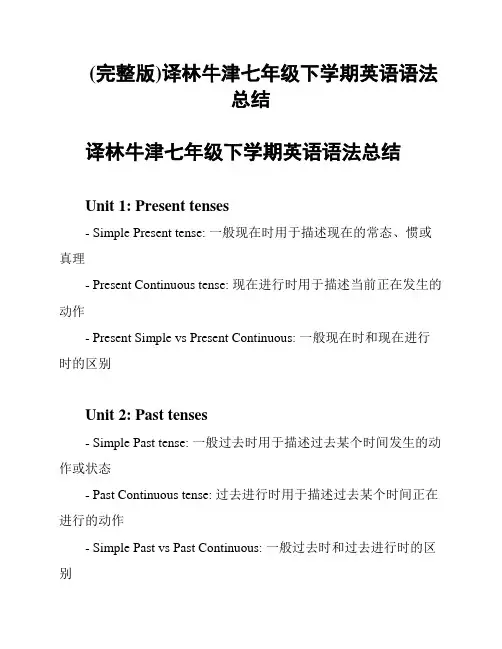
(完整版)译林牛津七年级下学期英语语法总结译林牛津七年级下学期英语语法总结Unit 1: Present tenses- Simple Present tense: 一般现在时用于描述现在的常态、惯或真理- Present Continuous tense: 现在进行时用于描述当前正在发生的动作- Present Simple vs Present Continuous: 一般现在时和现在进行时的区别Unit 2: Past tenses- Simple Past tense: 一般过去时用于描述过去某个时间发生的动作或状态- Past Continuous tense: 过去进行时用于描述过去某个时间正在进行的动作- Simple Past vs Past Continuous: 一般过去时和过去进行时的区别Unit 3: Future tenses- Will + verb: 表示将来的决定、打算或预测- Be going to + verb: 表示计划、意图或预测- Future Continuous tense: 将来进行时用于描述将来某个时间正在进行的动作- Future Simple vs Be going to: 将来时的两种表达方式的区别Unit 4: Passive voice- Active voice vs Passive voice: 主动语态和被动语态的区别- How to form the passive voice: 构成被动语态的方法- Passive voice with different tenses: 不同时态的被动语态形式Unit 5: Modal verbs- Can, could, may, might: 表示能力、允许或可能性- Must, have to: 表示必须、责任或推测- Should, ought to: 表示应该、建议或期望Unit 6: Conditionals- Zero conditional: 表示真理、自然法则或普遍情况- First conditional: 表示可能性、条件或可能的反应- Second conditional: 表示假设、不太可能的情况或对应的行动- Third conditional: 表示虚构、过去的假设或悔恨Unit 7: Reported speech- Reporting verbs: 常用的引述动词- Reporting statements: 直接引述陈述句的变化- Reporting questions: 直接引述疑问句的变化以上是译林牛津七年级下学期英语语法总结的内容。
牛津译林版英语初二上册语法规则总结
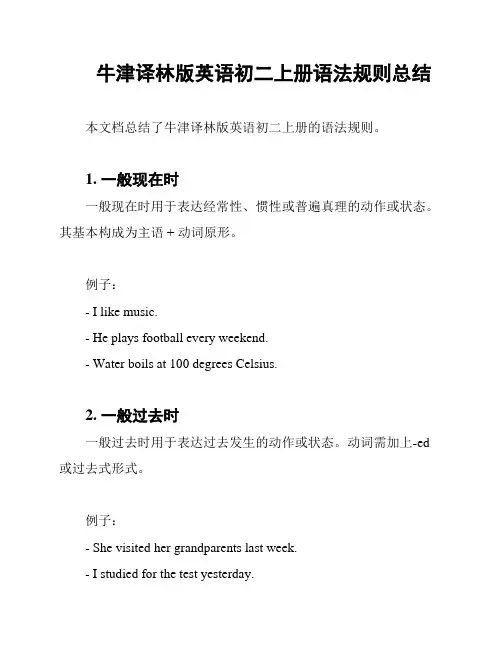
牛津译林版英语初二上册语法规则总结本文档总结了牛津译林版英语初二上册的语法规则。
1. 一般现在时一般现在时用于表达经常性、惯性或普遍真理的动作或状态。
其基本构成为主语 + 动词原形。
例子:- I like music.- He plays football every weekend.- Water boils at 100 degrees Celsius.2. 一般过去时一般过去时用于表达过去发生的动作或状态。
动词需加上-ed 或过去式形式。
例子:- She visited her grandparents last week.- I studied for the test yesterday.- They played basketball for two hours.3. 现在进行时现在进行时用于表达目前正在进行的动作。
其构成为主语 + am/is/are + 动词-ing形式。
例子:- We are watching a movie right now.- The baby is sleeping.4. 一般将来时一般将来时用于表达将来某个时间会发生的动作。
其构成为主语 + will + 动词原形。
例子:- We will go shopping tomorrow.- She will call you later.- They will visit their relatives next month.5. 一般过去将来时一般过去将来时用于过去将来某个时间会发生的动作。
其构成为主语 + was/were going to + 动词原形。
例子:- He said he was going to visit his parents yesterday.- I thought we were going to have a meeting last night.6. 祈使句祈使句用于表示命令、请求或建议。
译林牛津七年级上学期英语语法知识总结
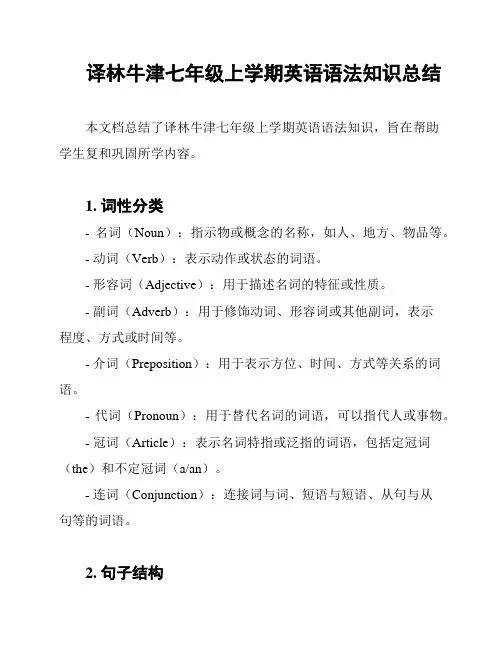
译林牛津七年级上学期英语语法知识总结本文档总结了译林牛津七年级上学期英语语法知识,旨在帮助学生复和巩固所学内容。
1. 词性分类- 名词(Noun):指示物或概念的名称,如人、地方、物品等。
- 动词(Verb):表示动作或状态的词语。
- 形容词(Adjective):用于描述名词的特征或性质。
- 副词(Adverb):用于修饰动词、形容词或其他副词,表示程度、方式或时间等。
- 介词(Preposition):用于表示方位、时间、方式等关系的词语。
- 代词(Pronoun):用于替代名词的词语,可以指代人或事物。
- 冠词(Article):表示名词特指或泛指的词语,包括定冠词(the)和不定冠词(a/an)。
- 连词(Conjunction):连接词与词、短语与短语、从句与从句等的词语。
2. 句子结构- 主语(Subject):句子中进行动作或被描述的人、事物或概念。
- 谓语(Predicate):句子中表达动作或状态的部分,通常是动词。
- 宾语(Object):动作的承受者或受益者,是动词的补充部分。
- 定语(Attributive):用于修饰名词或代词的形容词、副词等。
- 状语(Adverbial):修饰动词或整个句子的副词、介词短语等。
3. 时态与语态- 时态(Tense):表示动作发生的时间,如一般现在时、过去时、将来时等。
- 语态(Voice):表示动作的主体和动作所受的影响关系,如主动语态和被动语态。
4. 句型结构- 简单句(Simple Sentence):只包含一个主语和一个谓语的句子。
- 并列句(Coordination Sentence):由并列连词连接的两个或多个简单句。
- 疑问句(Question Sentence):用于提问的句子,通常以疑问词开头或动词倒装。
以上是关于译林牛津七年级上学期英语语法知识的简要总结。
希望这份文档能够帮助你更好地复习和应用所学的语法知识。
祝你学习进步!。
初中英语苏教版知识点总结
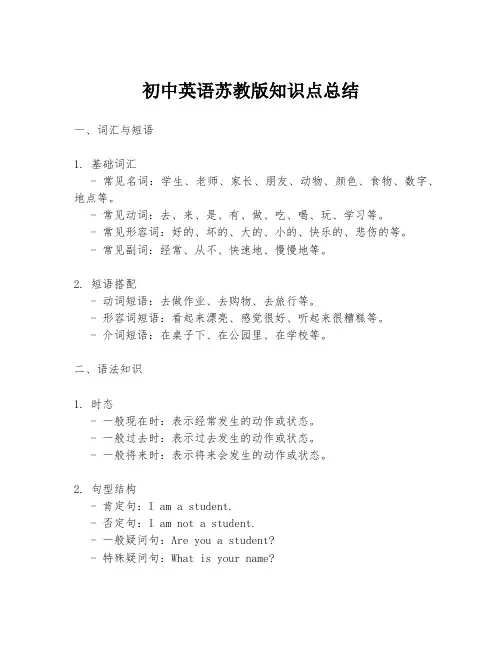
初中英语苏教版知识点总结一、词汇与短语1. 基础词汇- 常见名词:学生、老师、家长、朋友、动物、颜色、食物、数字、地点等。
- 常见动词:去、来、是、有、做、吃、喝、玩、学习等。
- 常见形容词:好的、坏的、大的、小的、快乐的、悲伤的等。
- 常见副词:经常、从不、快速地、慢慢地等。
2. 短语搭配- 动词短语:去做作业、去购物、去旅行等。
- 形容词短语:看起来漂亮、感觉很好、听起来很糟糕等。
- 介词短语:在桌子下、在公园里、在学校等。
二、语法知识1. 时态- 一般现在时:表示经常发生的动作或状态。
- 一般过去时:表示过去发生的动作或状态。
- 一般将来时:表示将来会发生的动作或状态。
2. 句型结构- 肯定句:I am a student.- 否定句:I am not a student.- 一般疑问句:Are you a student?- 特殊疑问句:What is your name?3. 代词- 人称代词:I, you, he, she, it, we, they.- 物主代词:my, your, his, her, its, our, their.- 反身代词:myself, yourself, himself, herself, itself, ourselves, yourselves, themselves.4. 冠词- 不定冠词:a, an.- 定冠词:the.5. 介词- 表示时间:at, on, in.- 表示地点:at, on, in, under, above, behind.- 表示方向:to, towards, through.6. 连词- 并列连词:and, but, or, so.- 从属连词:because, since, although, if, when, while.三、阅读理解1. 文章类型- 记叙文:讲述人物、事件的故事。
- 说明文:解释事物的特性、原因、过程等。
英语初一上册语法知识点总结译林
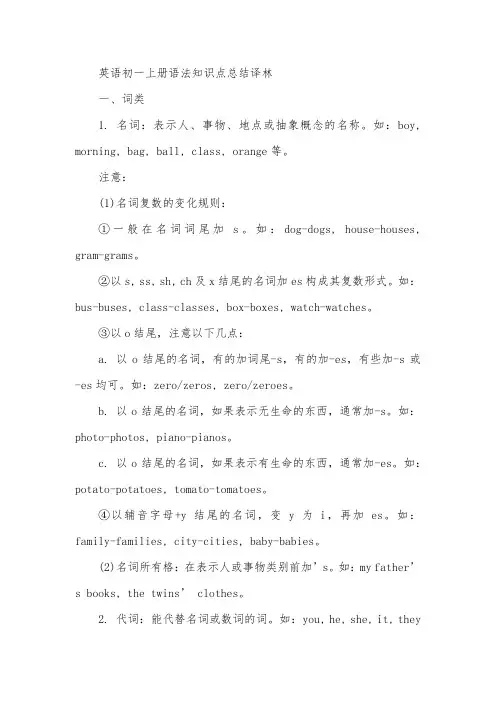
英语初一上册语法知识点总结译林一、词类1. 名词:表示人、事物、地点或抽象概念的名称。
如:boy, morning, bag, ball, class, orange等。
注意:(1)名词复数的变化规则:①一般在名词词尾加s。
如:dog-dogs, house-houses, gram-grams。
②以s, ss, sh, ch及x结尾的名词加es构成其复数形式。
如:bus-buses, class-classes, box-boxes, watch-watches。
③以o结尾,注意以下几点:a. 以o结尾的名词,有的加词尾-s,有的加-es,有些加-s或-es均可。
如:zero/zeros, zero/zeroes。
b. 以o结尾的名词,如果表示无生命的东西,通常加-s。
如:photo-photos, piano-pianos。
c. 以o结尾的名词,如果表示有生命的东西,通常加-es。
如:potato-potatoes, tomato-tomatoes。
④以辅音字母+y结尾的名词,变y为i,再加es。
如:family-families, city-cities, baby-babies。
(2)名词所有格:在表示人或事物类别前加’s。
如:my father’s books, the twins’ clothes。
2. 代词:能代替名词或数词的词。
如:you, he, she, it, they等。
注意:(1)人称代词主格和宾格的用法:主格作主语,宾格作宾语。
如:He is Chinese. (主格) Let me help you.(宾格)(2)物主代词的用法:形容词性物主代词后面一定要跟名词,名词性物主代词可作主语、宾语和表语。
如:This is my book.(形容词性) These books are theirs.(名词性)(3)反身代词的用法:表示“自己”,既可作宾语,又可作同位语。
如:He can do it himself.(作宾语) Himself is an excellent student.(作同位语)3. 动词:表示动作或状态的词。
译林牛津七年级上学期英语语法规则总结
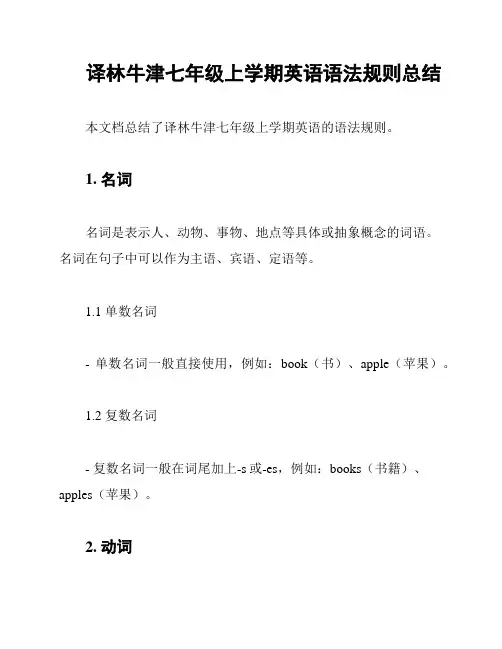
译林牛津七年级上学期英语语法规则总结本文档总结了译林牛津七年级上学期英语的语法规则。
1. 名词名词是表示人、动物、事物、地点等具体或抽象概念的词语。
名词在句子中可以作为主语、宾语、定语等。
1.1 单数名词- 单数名词一般直接使用,例如:book(书)、apple(苹果)。
1.2 复数名词- 复数名词一般在词尾加上-s或-es,例如:books(书籍)、apples(苹果)。
2. 动词动词表示动作或状态的词语。
动词在句子中可以作为谓语、宾语、定语等。
2.1 一般现在时- 一般现在时用于表示经常性或普遍性的行为或状态,例如:I go to school every day(我每天去学校)。
2.2 动词原形- 动词原形用于表示对某事物的普遍性描述,例如:Water boils at 100 degrees Celsius(水在100摄氏度烧开)。
3. 形容词形容词用于修饰名词或代词,表示人或事物的性质或特征。
3.1 形容词的比较级- 形容词的比较级用于比较两个人或事物的差异,例如:She is taller than me(她比我高)。
3.2 形容词的最高级- 形容词的最高级用于比较三个或更多人或事物的差异,例如:He is the tallest boy in the class(他是班级里最高的男孩)。
4. 副词副词用于修饰动词、形容词或其他副词,表示时间、地点、方式、程度等。
4.1 副词的用法- 副词可以修饰动词、形容词或其他副词,例如:She runs quickly(她跑得快)。
5. 介词介词用于表示人或事物在时间、地点、方式等方面的关系。
5.1 常见介词- 常见的介词有in(在)、on(在上面)、at(在...处)等,例如:He is studying in the library(他在图书馆研究)。
6. 冠词冠词用于限定名词。
6.1 定冠词- 定冠词用于表示特定的、已知的人或事物,例如:The book on the table is mine(桌子上的那本书是我的)。
苏教版(译林版)初中英语各册单元语法点复习梳理
苏教版(译林版)初中英语各册单元语法点复习梳理教材单元Unit 1 This is me!Unit 2 Let ’ s play sportsUnit 3 Welcome to our school7AUnit 4 My dayUnit 5 Let ’ s celebrate!Unit 6 Food and lifestyleUnit 7 ShoppingUnit 8 FashionUnit 1 Dream homesUnit 2 NeighborsUnit 3 Welcome to SunshineTown!7BUnit 4 Finding your wayUnit 5 Amazing thingsUnit 6 Outdoor funUnit 7 AbilitiesUnit 8 PetsUnit 1 FriendsUnit 2 School life8AUnit 3 A day outUnit 4 Do it yourselfUnit 5 Wild animals复习自评主要语法项目(备注)Simple present tense of theverb to beSimple present tense of theverb to doA:Personalpronouns(subject form)B:Personalpronouns(object form)A:Prepositions of timeB:Adverbs of frequencyAsking Wh- questionsCountable anduncountable nounsA:Using some/anyB:Using there be Presentcontinuous tenseA:Cardinal numbersB:Ordinal numbersA:Simple future tense withwill and shallB:Simple future tense withbe going toA:Noun + ’ sB:Possessive adjectivesand pronounsA:Using a, an and theB:Prepositions of placeSimple past tense(I)Simple past tense(II)A:Using can, could and mayB:Using What and Howto express strong feelingsA:Using adjectivesB:Indefinite pronounsComparative andsuperlative adjectivesA:Comparing the amountof thingsB:Comparative andsuperlative adverbsA:Using as...asB:Reflective pronounsA:Giving introductionsB:Using should and had betterA: Using may for possibility8B 9A Unit 6 BirdwatchingUnit 7 SeasonsUnit 8 Natural disastersUnit 1 Past and presentUnit 2 TravellingUnit 3 Online toursUnit 4 A good readUnit 5 Good mannersUnit 6 Sunshine for allUnit 7 International charitiesUnit 8 A green worldUnit 1 Know yourselfUnit 2 ColoursUnit 3 Teenage problemsUnit 4 Growing upUnit 5 Art worldUnit 6 TV programmesUnit 7 FilmsB:Using verbs +to-infinitiveA:Using to-infinitive forpurposeB:Using verbs+ to-infinitivesVerbs and sentence structuresA:Past continuous tenseB:Using when,while and asPresent perfect tenseA: Using have/has beenand have/has goneB: Verbs with for and sinceSimple past tense andpresent perfect tenseA:Using questionwords +to-infinitivesB:Using must and haveto A Using enough toB Using too...toA:It is+adjective+ to –infinitiveB:It is +adjective+ for ...+to-infinitiveC:It is + adjective +of ...+to-infinitive Passivevoice in the simple presentand past tenses Passivevoice in the simple futuretenseA:Using and, but, or and soB:Using both ... and ..., notonly ... but (also) ..., either ...or ... and neither ... nor ...A:Object clauses introduced bythatB:Object clauses introducedby if or whetherA:Object clauses introduced byquestion wordsB: Giving suggestionsA:Using before, after, whenand whileB:Using since, till and untilC:Using as soon as andwheneverA:Giving reasons with becauseB:Giving reasons with sinceandasA:Using ifB:Using unlessA: Using although/thoughB: Using so ... that and such ... thatC: Using so thatUnit 8 Detective stories A Defining relative clausesB Relative pronouns Uses of itA: Using it as a pronounUnit 1 Asia B: Using it as a impersonal pronounC: Using it to replace the real subject or objectTensesA: Simple present and present continuousUnit 2 Famous people B: Simple past and pastcontinuousC: Simple past and presentperfect9B SentencesA: Using object clauses orobjects + object complements Unit 3 Robots B: Using object clauses orquestion words + to –infinitivesC Using adverbial clauses orto-infinitiveSentencesA: Using adverbial clausesor simple sentencesUnit 4 Life on Mars B: Using object clauses orsimple sentencesC:Using defining relativesclauses or simple sentences。
苏教版译林牛津重点初中英语语法总结归纳(初一初二
补充:1.句子的构成初中一年级上语法1.in,on,at表示时间的应用in +parts of day(evening,morning,etc) /month/season/yearon + day (Sunday, etc)/date(1 July,etc)/parts of a special day( Sunday morning)/special holidays(Children’sDay)at + time of day (seven o’clock)/ age(6 years old)2.频率副词1.比较级、最高级的用法than作为比较级、the+最高级的用法+er 及+est 的用法,most+形容词表示最高级2. more…than, fewer….than,less..than, the most, the fewest, the least的用法3. as…as的用法4.反身代词的用法Myself, yourself, himself, herself, itself, ourselves, yourselves, themselves5.祈使句的用法肯定:Open the door.否定:Don’t close the window.礼貌些:Please….6.表示建议should和had better的用法7.may来表示可能性的用法(区别初一下7,may作为询问语气的用法)8.不定式用法9.用不定式表示目的,用in order to表示目的10. A.“动词+宾语+不定式”结构,即,动词+宾语+to do(不定式)可用这类结构的常用动词有?advise, allow, ask, bear, beg, bother, cause, command, determine, encourage, expect, forbid, force, get, hate, help, intend, invite, leave, like, mean, need, order, permit, persuade, prefer, request, remind, request, teach, tell, trouble, want, warn, wish等。
苏教版译林版初中英语各年级知识点
Unit3Teenage problems
Unit4Growing up
Unit5Art world
Unit6TV programmes
Unit7Films
Unit8Detective stories[侦探小说]
9B
Unit1Asia
Unit2Great people
Unit3Robots
Unit4Life on Mars
7A
1动词be的一般现在时
2行为动词的一般现在时
3人称代词
4表示时间的介词
5频度副词
6特殊疑问句
7可数名词和不可数名词
8用some和any表示数量
9 there beபைடு நூலகம்构
10 现在进行时
7B
1 基数词
2 序数词
3 一般将来时(will shall)
4 一般将来时(be going to)
4 一般过去时和过去进行时
5 一般过去时和现在完成时
6 简单句和复合句之间的转换(一)
7 简单句和复合句之间的转换(二)
苏教版译林版初中英语各年级知识点(总4页)
7A
Unit1This is me!
Unit2Let’s play sports!
Unit3Welcome to our school!
Unit4My day
Unit5Let’s celebrate!
Unit6Food and lifestyles
Unit7Shopping
Unit2Travelling
Unit3Online tours
Unit4A good read
Unit5Good manners[彬彬有礼]
译林初中英语知识点总结
译林初中英语知识点总结一、词汇与短语1. 基础词汇- 常见名词:学生、老师、家庭、动物、食物、颜色、数字、职业等。
- 常见动词:吃、喝、玩、学习、工作、旅行等。
- 常见形容词:高兴的、悲伤的、美丽的、丑陋的、大的、小的等。
- 常见副词:快速地、慢慢地、经常、从不等。
2. 短语搭配- 动词短语:看起来(look like)、听起来(sound like)、玩得开心(have fun)、学习英语(learn English)等。
- 介词短语:在桌子下(under the table)、在公园里(in the park)、对…感兴趣(be interested in)等。
- 常用表达:问候(Hello/Hi)、道别(Goodbye/See you)、感谢(Thank you)、道歉(Sorry)等。
二、语法结构1. 时态- 一般现在时:表示经常发生的动作或状态,如:I go to school every day.- 一般过去时:表示过去某一确定时间发生的动作或状态,如:He visited the museum last week.- 一般将来时:表示将来某一时间会发生的动作或状态,如:They will travel to Japan next year.2. 句型- 肯定句:I am a student.- 否定句:I am not a student.- 疑问句:Are you a student?- 特殊疑问句:What is your name? / Where are you from?3. 语态- 被动语态:表示动作的承受者,如:The book was written by the author.4. 非谓语动词- 动名词:作为名词使用,如:Swimming is my hobby.- 分词:作为形容词或副词使用,如:The running boy is my friend.- 不定式:作为名词、形容词、副词等,如:To err is human.三、阅读理解1. 技巧- 快速阅读:通过扫读(skimming)和略读(scanning)快速获取文章大意。
- 1、下载文档前请自行甄别文档内容的完整性,平台不提供额外的编辑、内容补充、找答案等附加服务。
- 2、"仅部分预览"的文档,不可在线预览部分如存在完整性等问题,可反馈申请退款(可完整预览的文档不适用该条件!)。
- 3、如文档侵犯您的权益,请联系客服反馈,我们会尽快为您处理(人工客服工作时间:9:00-18:30)。
补充:1.句子的构成
初中一年级上语法
,on,at表示时间的应用
in +parts of day(evening,morning,etc) /month/season/year
on + day (Sunday, etc)/date(1 July,etc)/parts of a special day( Sunday morning)/special holidays(Children’s Day)
at + time of day (seven o’clock)/ age(6 years old)
2.频率副词
never, seldom,sometimes,often,usually,always
3.疑问副词的用法
what,which,who,whose,when,why,how
4.可数名词与不可数名词
和any的用法
be句型
7.现在进行时及动词+ing的用法
初中一年级下语法
1.序数词与基数词
2.一般将来时:will与shall、be going to
3.名词所有格
名字+’s,mine,yours,ours,theirs,his,hers,its
4.冠词a,an, the的用法
5.表示方位的介词
In front of, behind,inside,outside,above,below,over,under
6.一般过去式及过去分词+ed的用法
,could,may的用法
和How开头的感叹句
9形容词的用法,在句子中的位置
10.不定代词的用法
Somebody, someone, something
Anybody, anyone, anything
Nobody, no one, nothing
Everybody, everyone, everthing
初中二年级上语法
1.比较级、最高级的用法
than作为比较级、the+最高级的用法
+er 及+est 的用法,most+形容词表示最高级
2. more…than, fewer….than,less..than, the most, the fewest, the least的用法
3. as…as的用法
4.反身代词的用法
Myself, yourself, himself, herself, itself, ourselves, yourselves, themselves
5.祈使句的用法
肯定:Open the door.
否定:Don’t close the window.
礼貌些:Please….
6.表示建议should和had better的用法
来表示可能性的用法(区别初一下7,may作为询问语气的用法)
8.不定式用法
9.用不定式表示目的,用in order to表示目的
10. A.“动词+宾语+不定式”结构,即,动词+宾语+to do(不定式)
可用这类结构的常用动词有?advise, allow, ask, bear, beg, bother, cause, command, determine, encourage, expect, forbid, force, get, hate, help, intend, invite, leave, like, mean, need, order, permit, persuade, prefer, request, remind, request, teach, tell, trouble, want, warn, wish等。
B.不需要加to的动词:
使役动词:make, let等
感官动词:see, hear等
(关于各种动词的用法,后续有专题讲解)
11.句型:
主语+谓语
主语+谓语+宾语
主语+谓语+表语
主语+谓语+间接宾语+直接宾语
主语+谓语+直接宾语+间接宾语
12.过去进行时
, while, as的用法及区别
初中二年级下语法
1.现在完成时Unit1
/has been与have /has gone 区别Unit2
3. 一般过去时,过去完成时Unit3
4.疑问词+不定式Unit4
What to…
Who to…
When to…
Where to…
Which to…
How to…
enough to:
to be+adj.+enough+不定式
Too...to:
To be + too +adj.+不定式unit5
6. It is+adj.+for+不定式Unit6
It is+adj+of+不定式
7.被动语态及其在一般现在时和一般过去时中的应用Unit7
8.被动语态在一般将来时中的应用Unit8。
